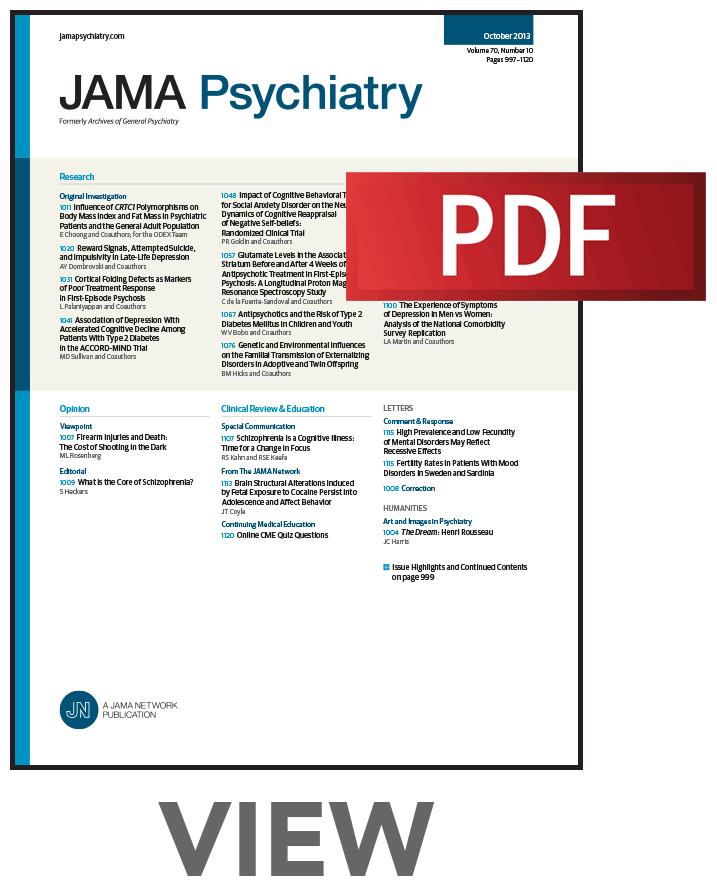美国18 - 64岁成人处方兴奋剂的使用、误用和使用障碍
IF 22.5
1区 医学
Q1 PSYCHIATRY
引用次数: 0
摘要
重要性越来越多的美国成年人服用兴奋剂。这种处方是否与滥用和处方兴奋剂使用障碍(PSUD)有关尚不清楚。目的研究(1)2019 - 2022年按性别和年龄划分的兴奋剂配药人数和处方兴奋剂配药趋势;(二)处方安非他明类兴奋剂(以下简称安非他明)和哌甲酯滥用和PSUD的情况;(3)处方兴奋剂滥用者与非处方兴奋剂滥用者之间PSUD患病率与社会人口统计学和行为健康的相关性。设计、设置和参与者本横断面调查研究使用了2019-2022年IQVIA总患者追踪器和国家处方审计新品牌数据库以及2021-2022年国家药物使用和健康调查(NSDUH)(社区居住的18至64岁个体)。数据分析时间为2024年3月至4月。暴露:过去一年使用处方兴奋剂。主要结果和测量方法采用DSM-5标准。结果83762例18 ~ 64岁成人中,18 ~ 25岁占33.8%(未加权),26 ~ 49岁占53.0%(未加权),女性占56.0%(未加权)。在使用处方兴奋剂的患者中,25.3% (95% CI, 23.8%-26.8%)报告滥用,9.0% (95% CI, 8.0%-10.0%)发生PSUD。在PSUD患者中,72.9% (95% CI, 68.3%-77.6%)单独使用自己规定的兴奋剂,87.1% (95% CI, 82.3%-90.8%)使用安非他明,42.5% (95% CI, 36.6%-48.5%)报告没有滥用,63.6% (95% CI, 56.8%-69.8%)有轻度PSUD。使用安非他明的个体,与使用哌甲酯的个体相比,有更高的滥用患病率(3.1 [95% CI, 2.2-4.3])和PSUD (2.2 [95% CI, 1.3-3.8])。发放处方兴奋剂的人数增幅最大的是35至64岁的女性,从2019年第一季度的120万增加到2022年第四季度的170万(平均季度百分比变化为2.6% [95% CI, 2.1%-3.1%])。35-64岁女性滥用处方兴奋剂的发生率(13.7% [95% CI, 11.1%-16.8%])低于其他性别和年龄特异性亚组(35-64岁男性为22.0% [95% CI, 17.9%-26.7%], 18-25岁女性为36.8% [95% CI, 32.6%-41.2%])。结论和相关性处方兴奋剂滥用和PSUD的高患病率(无论滥用状况如何)表明,在所有处方兴奋剂,特别是使用安非他明的成年人中,确保临床适当使用和筛查和治疗PSUD的重要性。研究结果可能表明,在解决中年妇女心理卫生保健差距方面可能取得进展,需要对成人处方兴奋剂的益处和风险进行循证临床指导和培训。本文章由计算机程序翻译,如有差异,请以英文原文为准。
Prescription Stimulant Use, Misuse, and Use Disorder Among US Adults Aged 18 to 64 Years
ImportanceStimulants are increasingly prescribed for US adults. Whether such prescribing is associated with misuse and prescription stimulant use disorder (PSUD) is less understood.ObjectivesTo examine (1) sex- and age-specific trends in the number of persons dispensed stimulants and trends in dispensed prescription stimulants by prescriber specialty in 2019 through 2022; (2) prevalence of misuse and PSUD by use of prescription amphetamine-type stimulants (hereafter referred to as amphetamines ) and methylphenidate; and (3) PSUD prevalence and sociodemographic and behavioral health correlates among persons using prescription stimulants with and without prescription stimulant misuse.Design, Setting, and ParticipantsThis cross-sectional survey study used the 2019-2022 IQVIA Total Patient Tracker and National Prescription Audit New to Brand databases and the 2021-2022 National Surveys on Drug Use and Health (NSDUH) (community-dwelling 18- to 64-year-old individuals). Data analysis was performed from March to April 2024.ExposurePast-year use of prescription stimulants.Main Outcomes and MeasuresPSUD using DSM-5 criteria.ResultsOf the sampled 83 762 adults aged 18 to 64 years, 33.8% (unweighted) were aged 18 to 25 years, 53.0% (unweighted) were aged 26 to 49 years, and 56.0% (unweighted) were women. Among those using prescription stimulants, 25.3% (95% CI, 23.8%-26.8%) reported misuse, and 9.0% (95% CI, 8.0%-10.0%) had PSUD. Among those with PSUD, 72.9% (95% CI, 68.3%-77.6%) solely used their own prescribed stimulants, 87.1% (95% CI, 82.3%-90.8%) used amphetamines, 42.5% (95% CI, 36.6%-48.5%) reported no misuse, and 63.6% (95% CI, 56.8%-69.8%) had mild PSUD. Individuals using amphetamines, compared with those using methylphenidate, had higher prevalence ratios of misuse (3.1 [95% CI, 2.2-4.3]) and PSUD (2.2 [95% CI, 1.3-3.8]). The largest increase in the number of individuals dispensed prescription stimulants was among women aged 35 to 64 years, from 1.2 million in quarter 1 of 2019 to 1.7 million in quarter 4 of 2022 (average quarterly percentage change, 2.6% [95% CI, 2.1%-3.1%]). The prevalence of prescription stimulant misuse was lower among women aged 35 to 64 years using these medications (13.7% [95% CI, 11.1%-16.8%]) than other sex- and age-specific subgroups (ranging from 22.0% [95% CI, 17.9%-26.7%] for men aged 35-64 years to 36.8% [95% CI, 32.6%-41.2%] for women aged 18-25 years).Conclusions and RelevanceHigh prevalence of prescription stimulant misuse and PSUD (regardless of misuse status) suggests the importance of ensuring clinically appropriate use and of screening for and treating PSUD among all adults prescribed stimulants, especially those using amphetamines. Findings may suggest potential progress in addressing the mental health care gap for middle-aged women and the need for evidence-based clinical guidance and training on benefits and risks of prescription stimulants for adults.
求助全文
通过发布文献求助,成功后即可免费获取论文全文。
去求助
来源期刊

JAMA Psychiatry
PSYCHIATRY-
CiteScore
30.60
自引率
1.90%
发文量
233
期刊介绍:
JAMA Psychiatry is a global, peer-reviewed journal catering to clinicians, scholars, and research scientists in psychiatry, mental health, behavioral science, and related fields. The Archives of Neurology & Psychiatry originated in 1919, splitting into two journals in 1959: Archives of Neurology and Archives of General Psychiatry. In 2013, these evolved into JAMA Neurology and JAMA Psychiatry, respectively. JAMA Psychiatry is affiliated with the JAMA Network, a group of peer-reviewed medical and specialty publications.
 求助内容:
求助内容: 应助结果提醒方式:
应助结果提醒方式:


